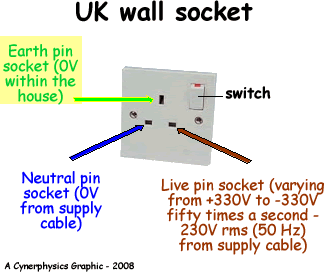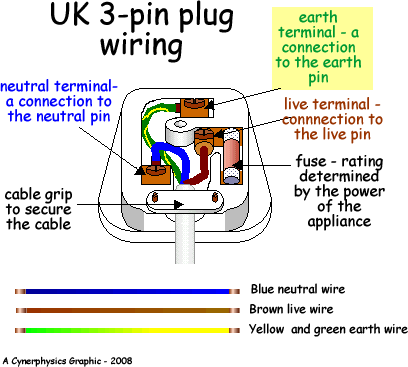The UK Domestic Wiring People in the UK access their electricity supply via electric sockets. These have connections to wires that run under the floor boards and behind the skirting boards of rooms. The 'Mains Supply' is brought into the house via the main fuse box and then distributed around the house using cabling under the floorboards and within walls. Sockets are fitted so that the house occupiers can access the electricity supply easily and safely. The wires are colour coded - the copper strands are encased in a coloured plastic sleeve:
The UK mains supply is about 230 volts AC (RMS). (It used to be 240V but it has been brought down to 230V - making it closer to the 220V used in Europe - this makes the sale of electrical goods produced in Europe and the UK more compatible and gives a wider market for appliances).
Most electrical appliances are connected to the UK Mains using cable and a 3-pin plug. The 3-pin plug can then be plugged into the socket and make a connection with the Mains Supply. In the 'olden days' wiring a plug was a skill you needed to have, but today most appliances have a fixed plug already attached and you rarely have to connect one yourself. Therefore the topic has gone 'off the syllabus'. But ask your grandma - she will know how to connect one! The 3-Pin plug
A plug has:
CablingA typical cable comprises of:
When connecting an appliance to a 3-pin plug:
Back in the day - when provided with appropriate diagrams you should be able to:
 Try the 'wiring a plug' crossword Try the 'wiring a plug' crossword
|
Follow me...
|



 The voltage is not a steady 230V. It varies sinusoidally with time at a frequency of 50Hz.
The voltage is not a steady 230V. It varies sinusoidally with time at a frequency of 50Hz.



